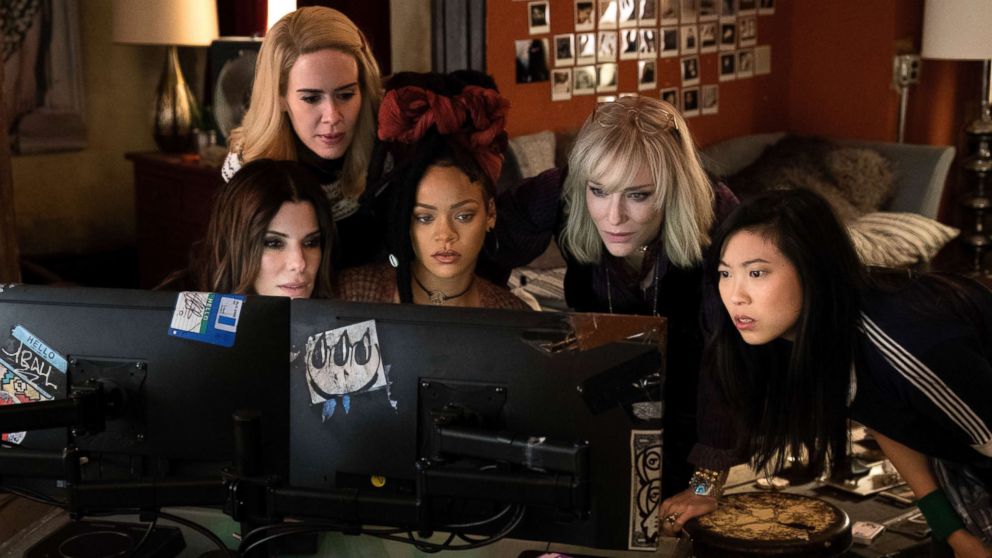
Women may be finding more success on screen -- "Ocean's 8" debuted at No. 1 this past weekend -- but they still lag behind when it comes to critiquing what's on the screen.
A new study out today by the University of Southern California's Annenberg School for Communication and Journalism, showed that the majority of film critics are white men.
"There is a really large disconnect between the people who are talking about films and the types of movies that are being made," Melissa Silverstein, the founder of the blog Women and Hollywood, told ABC News.
Using reviews of the top 100-grossing films of last year posted on the site Rotten Tomatoes, researchers found that only 22.2 percent of the 19,559 reviews evaluated were written by females. Among the reviews written by Rotten Tomatoes' designated "Top Critics," only 24 percent were penned by women.
An examination of Inclusion in film extends beyond the screen in the first report by @Inclusionists to investigate the landscape of film critics. #InclusionCrisis #30302020 #ascj https://t.co/SBeM6Tfg6Q pic.twitter.com/gm7P1kBVMU
— Annenberg Inclusion Initiative (@Inclusionists) June 11, 2018
Even films like "Girls Trip" and "Wonder Woman," with prominent female leads and disproportionately female audiences, were still overwhelming reviewed by white men. Women wrote just 30 percent of the reviews of the 36 highest-grossing female-driven films last year.
"The very individuals who are attuned to the under and misrepresentation of females on screen and behind the camera are often left out of the conversation and critiques," Stacy Smith, the report's co-author and founder of the Annenberg Inclusion Initiative, said in a press release.
Critics from underrepresented racial and ethnic backgrounds are also being left out.
White critics wrote 82 percent of the reviews of the top 100-grossing films of last year, while critics from underrepresented backgrounds authored just 18 percent -- even though, as the study points out, they come from groups that comprise 39 percent of the U.S. population.
Women of color fared the worst, writing only 4.1 percent of the reviews included in the study sample.
"This report reveals the absence of women of color working as reviewers — especially on movies built around female and underrepresented leads," says #DrStacyLSmith. #ascj Read more: https://t.co/gDQOQjrrsl
— Annenberg Inclusion Initiative (@Inclusionists) June 11, 2018
Why does this matter? Longtime film critic Thelma Adams told ABC News, "It's critical to remember that these are the gatekeepers and they are very important."
Adams points to the example of Lisa Cholodenko's "Laurel Canyon," which opened at Cannes in 2002. "It was a good movie, but it was killed at Cannes by a male critic," she said. "Those kinds of things slow down directors."
It took Cholodenko eight years to release her next movie, "The Kids Are All Right," in 2010.
"The underlying point is men and women see things differently," Adams said. "You're going to have a disconnect even if you get more women directing female driven content, there's going to be a disconnect."
For movies like "Ocean's 8" and "Girls Trip," reviews don't tend to matter as much.
"But there are a lot of smaller female-driven movies that need to be nurtured and have critics that understand them," Adams said.
The simple solution is to hire more women and people of color. But, it's more complicated than that.
"The profession is skewed and the profession itself is dying," Adams explained. "Everybody is scrambling in a big musical chairs to keep their jobs. That doesn't inspire loyalty or change."
Adams, who has been a critic for the New York Post, Us Weekly, the New York Observer and Yahoo! Movies, said women need jobs where they can earn a living while honing their voice and literary skills as critics.
"There has to be a way for people to make a living at this," Silverstein said.
The Annenberg Inclusion Initiative proposes setting the goal of 30/30/20/20. "This is the U.S. population breakdown for white males, white females, underrepresented males and underrepresented females," Smith said.
As it currently stands, the field of film critics does not reflect the world in which we live. The newest report from @Inclusionists proposes several solutions for a more inclusive industry of film reviewers. Learn more about #30302020 here: https://t.co/SBeM6Tfg6Q #ascj pic.twitter.com/YbtNFQi4xQ
— Annenberg Inclusion Initiative (@Inclusionists) June 11, 2018
"We need a variety of voices, because people are going to have different opinions," Silverstein said. "This is about the more the merrier."